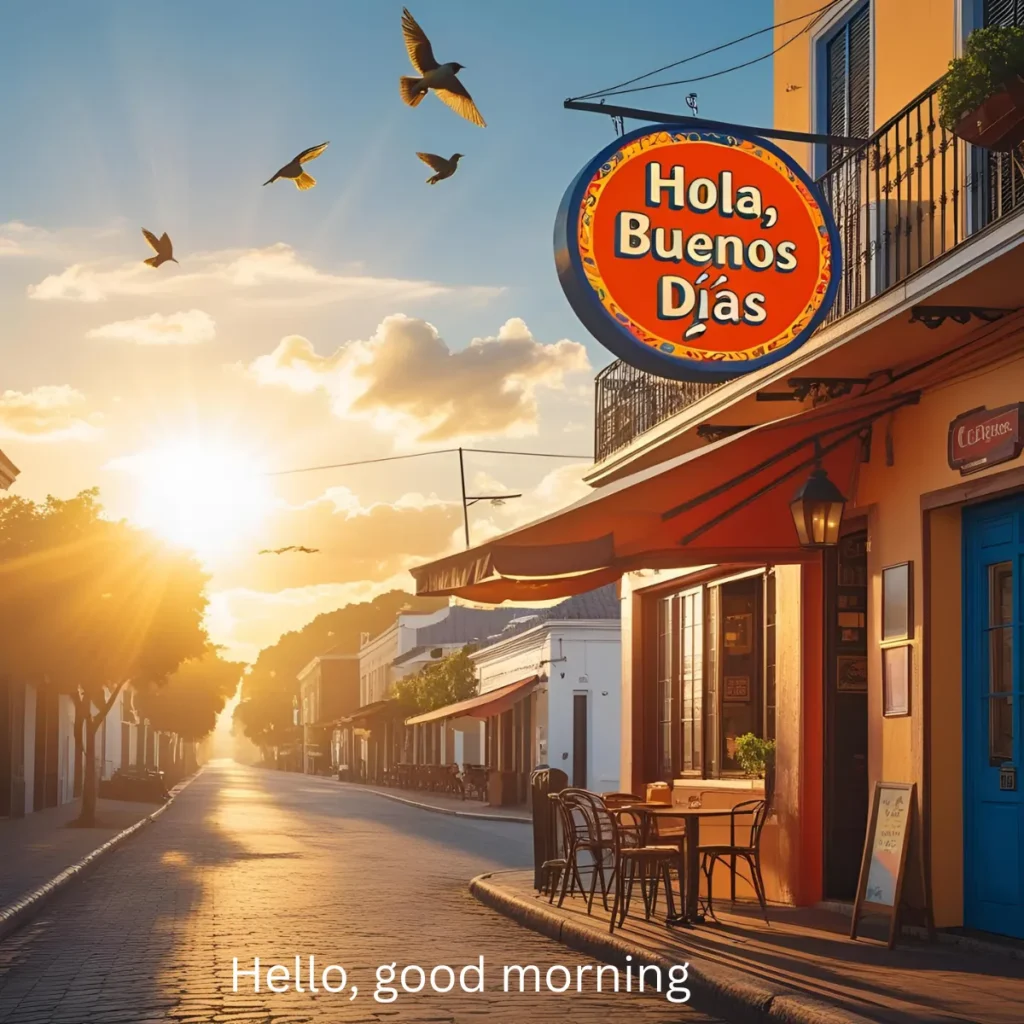Want to impress a Spanish-speaking girl with a warm, charming greeting? Knowing how to say “Good morning” in Spanish isn’t just about words—it’s about culture, tone, and connection. Whether you’re talking to a friend, a date, or someone you admire, the right phrase can make her smile. Spanish is a language full of emotion and expression—so why settle for just “Buenos días” when you have many more heartfelt options?
Here are 15 lovely and respectful ways to say “Good morning” to a girl in Spanish—with example conversations and a peek into their cultural roots.
1. Buenos días
Translation: Good morning
Origin: This is the standard and most widely used morning greeting in Spanish-speaking countries.
Example:
👤 User A: Buenos días, Ana. ¿Dormiste bien?
👤 User B: Buenos días, sí, gracias. ¿Y tú?
Use: Neutral and polite; perfect for any setting.
2. Buen día
Translation: Good day
Origin: Common in Argentina and parts of Latin America, especially in casual settings.
Example:
👤 User A: Buen día, Sofía. ¡Te ves radiante hoy!
👤 User B: ¡Gracias! Qué lindo eres. Buen día.
Use: Friendly and positive; often seen in Latin America.
3. Hola, buenos días

Translation: Hello, good morning
Origin: Combines two basic greetings to sound warmer and more polite.
Example:
👤 User A: Hola, buenos días, Camila. ¿Lista para la clase?
👤 User B: Hola, sí. ¡Vamos!
Use: Warm, respectful, slightly more formal.
4. Muy buenos días
Translation: A very good morning
Origin: Adds emphasis to express extra cheer or affection.
Example:
👤 User A: ¡Muy buenos días, princesa!
👤 User B: ¡Ay, qué tierno! Muy buenos días.
Use: Sweet, affectionate, and warm.
5. Buenos días, hermos
Translation: Good morning, beautiful
Origin: A romantic twist, often used with affection or flirtation.
Example:
👤 User A: Buenos días, hermosa. Soñé contigo.
👤 User B: ¡Qué romántico! Buenos días, guapo.
Use: Romantic or affectionate; use only with someone you’re close to.
6. Buenos días, mi amor
Translation: Good morning, my love
Origin: Deeply affectionate; common in relationships or among close loved ones.
Example:
👤 User A: Buenos días, mi amor. ¿Cómo amaneciste?
👤 User B: Muy bien ahora que te escucho. Buenos días.
Use: Intimate and romantic.
7. Hola, bella
Translation: Hello, beautiful
Origin: “Bella” is a poetic word for “beautiful” used across Spain and Latin America.
Example:
👤 User A: Hola, bella. ¿Lista para un nuevo día?
👤 User B: Hola, sí. Me alegra verte.
Use: Flirtatious or poetic.
8. Buenos días, guapa

Translation: Good morning, pretty girl
Origin: “Guapa” is common in Spain to compliment a woman’s appearance in a friendly or flirty way.
Example:
👤 User A: Buenos días, guapa. ¿Cómo estás hoy?
👤 User B: ¡Gracias! Estoy bien, ¿y tú?
Use: Friendly or slightly flirty; commonly used in Spain.
9. Buenos días, cariño
Translation: Good morning, sweetheart
Origin: “Cariño” is a term of endearment in many Spanish-speaking cultures.
Example:
👤 User A: Buenos días, cariño. ¿Quieres café?
👤 User B: ¡Claro! Qué amable eres.
Use: Affectionate and cozy.
10. ¡Qué tengas un lindo día
Translation: Have a lovely day!
Origin: Often used as a follow-up to “Buenos días”, especially in Latin America.
Example:
👤 User A: Buenos días, Paula. ¡Qué tengas un lindo día!
👤 User B: Gracias, tú también.
Use: Friendly, well-wishing.
11. Despierta, linda. Buenos días
Translation: Wake up, beautiful. Good morning
Origin: A tender phrase used in romantic or caring relationships.
Example:
👤 User A: Despierta, linda. Buenos días.
👤 User B: Mmm… ya desperté. Gracias, amor.
Use: Romantic or affectionate; use in close relationships.
12. Buenos días, reina

Translation: Good morning, queen
Origin: A playful and empowering greeting, especially on social media or text.
Example:
👤 User A: Buenos días, reina. Hoy vas a conquistar el mundo.
👤 User B: ¡Esa es la energía! Buenos días.
Use: Supportive, motivational, or flirtatious.
13. Buenos días, señorita
Translation: Good morning, miss
Origin: Polite and respectful; often used for young women or in formal situations.
Example:
👤 User A: Buenos días, señorita. ¿Cómo le va?
👤 User B: Muy bien, gracias. ¿Y a usted?
Use: Formal or polite setting.
14. Hola, dormilona
Translation: Hello, sleepyhead
Origin: A playful and cute way to greet someone who sleeps in.
Example:
👤 User A: Hola, dormilona. Ya es tarde.
👤 User B: Jajaja, ya me levanté. Buenos días.
Use: Fun and casual; perfect for friends or partners.
15. Buenos días, estrella
Translation: Good morning, star
Origin: A poetic or romantic phrase used to lift someone’s spirits.
Example:
👤 User A: Buenos días, estrella. Hoy vas a brillar.
👤 User B: ¡Gracias! Qué bonito.
Use: Uplifting, affectionate, poetic.
Conclousion:
🌞 Saying “Good Morning” in Spanish to a girl is a simple yet beautiful way to show kindness and warmth.
Whether you go with a classic “Buenos días”, a sweet “Buenos días, hermosa”, or a charming “Buen día, mi amor”, your words can brighten her day instantly. Just remember to speak from the heart — that’s what truly matters in any language. 💬❤️



